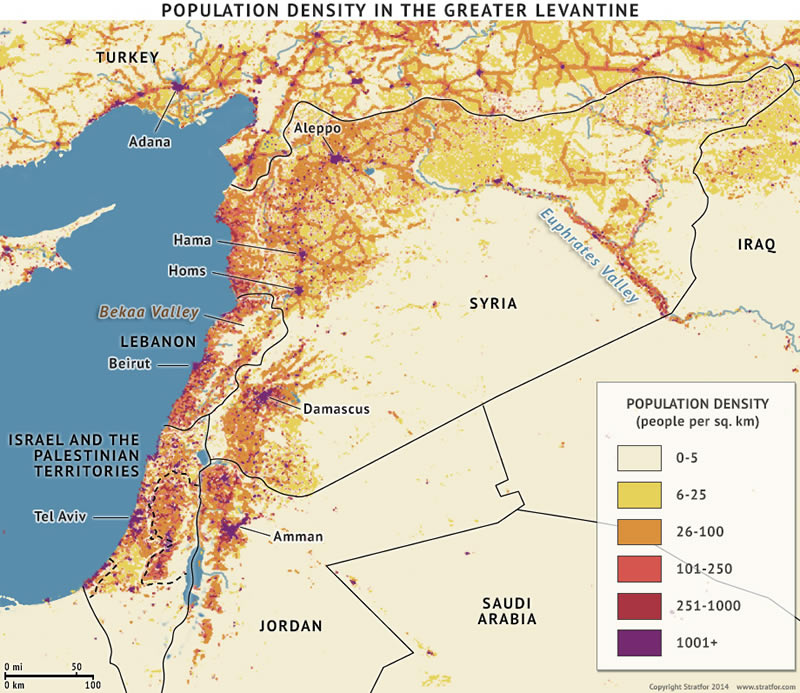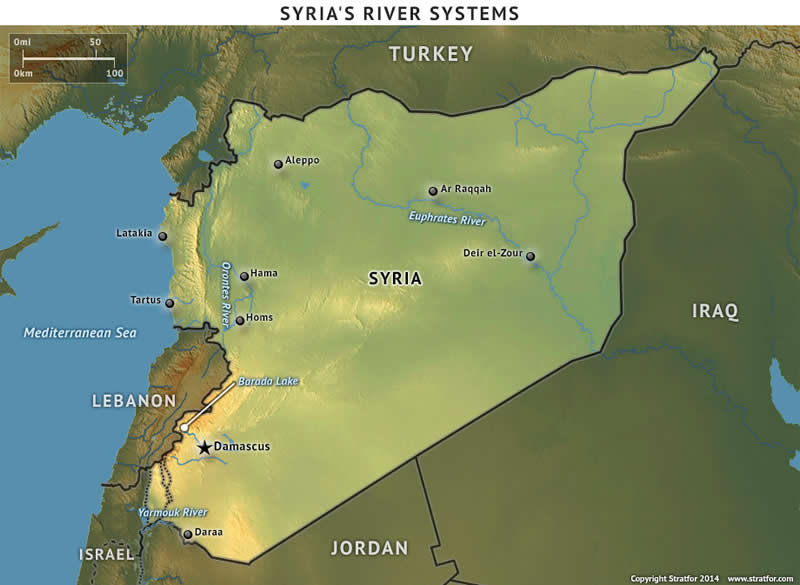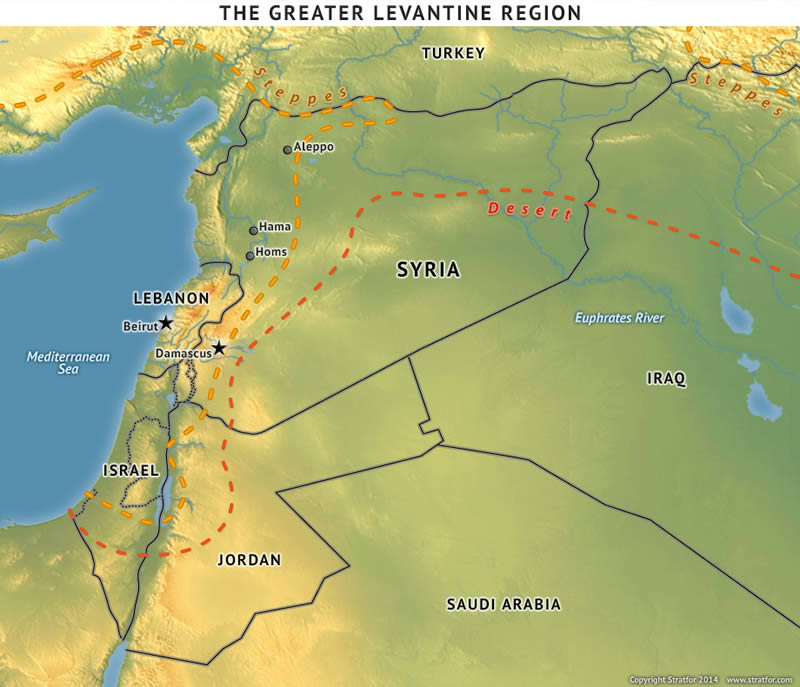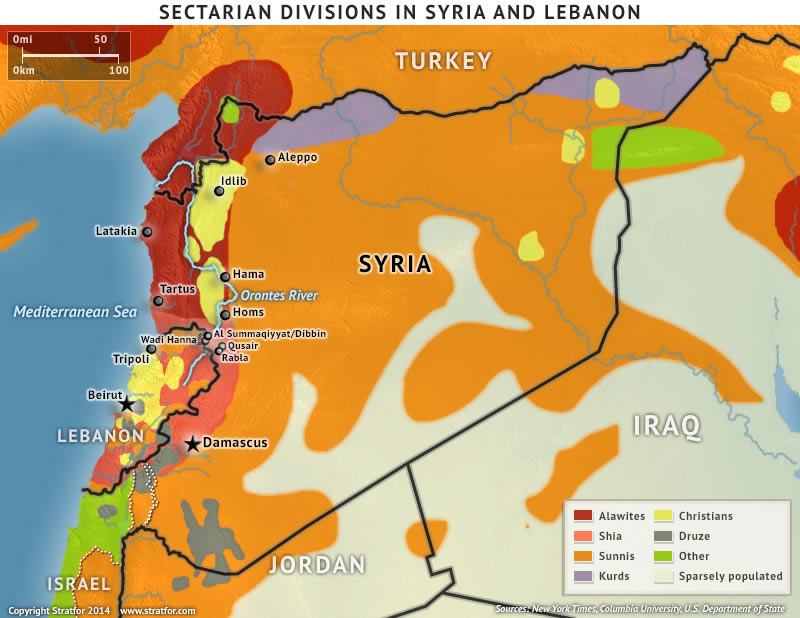The Geopolitics of the Syrian Civil War
Politics / Syria Jan 21, 2014 - 02:25 PM GMTBy: STRATFOR
 Reva Bhalla writes: International diplomats will gather Jan. 22 in the Swiss town of Montreux to hammer out a settlement designed to end Syria's three-year civil war. The conference, however, will be far removed from the reality on the Syrian battleground. Only days before the conference was scheduled to begin, a controversy threatened to engulf the proceedings after the United Nations invited Iran to participate, and Syrian rebel representatives successfully pushed for the offer to be rescinded. The inability to agree upon even who would be attending the negotiations is an inauspicious sign for a diplomatic effort that was never likely to prove very fruitful.
Reva Bhalla writes: International diplomats will gather Jan. 22 in the Swiss town of Montreux to hammer out a settlement designed to end Syria's three-year civil war. The conference, however, will be far removed from the reality on the Syrian battleground. Only days before the conference was scheduled to begin, a controversy threatened to engulf the proceedings after the United Nations invited Iran to participate, and Syrian rebel representatives successfully pushed for the offer to be rescinded. The inability to agree upon even who would be attending the negotiations is an inauspicious sign for a diplomatic effort that was never likely to prove very fruitful.
There are good reasons for deep skepticism. As Syrian President Bashar al Assad's forces continue their fight to recover ground against the increasingly fratricidal rebel forces, there is little incentive for the regime, heavily backed by Iran and Russia, to concede power to its sectarian rivals at the behest of Washington, especially when the United States is already negotiating with Iran. Ali Haidar, an old classmate of al Assad's from ophthalmology school and a long-standing member of Syria's loyal opposition, now serving somewhat fittingly as Syria's National Reconciliation Minister, captured the mood of the days leading up to the conference in saying "Don't expect anything from Geneva II. Neither Geneva II, not Geneva III nor Geneva X will solve the Syrian crisis. The solution has begun and will continue through the military triumph of the state."
Widespread pessimism over a functional power-sharing agreement to end the fighting has led to dramatic speculation that Syria is doomed either to break into sectarian statelets or, as Haidar articulated, revert to the status quo, with the Alawites regaining full control and the Sunnis forced back into submission. Both scenarios are flawed. Just as international mediators will fail to produce a power-sharing agreement at this stage of the crisis, and just as Syria's ruling Alawite minority will face extraordinary difficulty in gluing the state back together, there is also no easy way to carve up Syria along sectarian lines. A closer inspection of the land reveals why.
The Geopolitics of Syria
Before the 1916 Sykes-Picot agreement traced out an awkward assortment of nation-states in the Middle East, the name Syria was used by merchants, politicians and warriors alike to describe a stretch of land enclosed by the Taurus Mountains to the north, the Mediterranean to the west, the Sinai Peninsula to the south and the desert to the east. If you were sitting in 18th-century Paris contemplating the abundance of cotton and spices on the other side of the Mediterranean, you would know this region as the Levant -- its Latin root "levare" meaning "to raise," from where the sun would rise in the east. If you were an Arab merchant traveling the ancient caravan routes northward from the Hejaz, or modern-day Saudi Arabia, you would have referred to this territory in Arabic as Bilad al-Sham, or the "land to the left" of Islam's holy sites on the Arabian Peninsula.
Whether viewed from the east or the west, the north or the south, Syria will always find itself in an unfortunate position surrounded by much stronger powers. The rich, fertile lands straddling Asia Minor and Europe around the Sea of Marmara to the north, the Nile River Valley to the south and the land nestled between the Tigris and the Euphrates rivers to the east give rise to larger and more cohesive populations. When a power in control of these lands went roaming for riches farther afield, they inevitably came through Syria, where blood was spilled, races were intermixed, religions were negotiated and goods were traded at a frenzied and violent pace.

Consequently, only twice in Syria's pre-modern history could this region claim to be a sovereign and independent state: during the Hellenistic Seleucid dynasty, based out of Antioch (the city of Antakya in modern-day Turkey) from 301 to 141 B.C., and during the Umayyad Caliphate, based out of Damascus, from A.D. 661 to 749. Syria was often divided or subsumed by its neighbors, too weak, internally fragmented and geographically vulnerable to stand its own ground. Such is the fate of a borderland.
Unlike the Nile Valley, Syria's geography lacks a strong, natural binding element to overcome its internal fissures. An aspiring Syrian state not only needs a coastline to participate in sea trade and guard against sea powers, but also a cohesive hinterland to provide food and security. Syria's rugged geography and patchwork of minority sects have generally been a major hindrance to this imperative.
Syria's long and extremely narrow coastline abruptly transforms into a chain of mountains and plateaus. Throughout this western belt, pockets of minorities, including Alawites, Christians and Druze, have sequestered themselves, equally distrustful of outsiders from the west as they are of local rulers to the east, but ready to collaborate with whomever is most likely to guarantee their survival. The long mountain barrier then descends into broad plains along the Orontes River Valley and the Bekaa Valley before rising sharply once again along the Anti-Lebanon range, the Hawran plateau and the Jabal al-Druze mountains, providing more rugged terrain for persecuted sects to hunker down and arm themselves.

Just west of the Anti-Lebanon mountains, the Barada river flows eastward, giving rise to a desert oasis also known as Damascus. Protected from the coast by two mountain chains and long stretches of desert to the east, Damascus is essentially a fortress city and a logical place to make the capital. But for this fortress to be a capital worthy of regional respect, it needs a corridor running westward across the mountains to Mediterranean ports along the ancient Phoenician (or modern-day Lebanese) coast, as well as a northward route across the semi-arid steppes, through Homs, Hama and Idlib, to Aleppo.
The saddle of land from Damascus to the north is relatively fluid territory, making it an easier place for a homogenous population to coalesce than the rugged and often recalcitrant coastline. Aleppo sits alongside the mouth of the Fertile Crescent, a natural trade corridor between Anatolia to the north, the Mediterranean (via the Homs Gap) to the west and Damascus to the south. While Aleppo has historically been vulnerable to dominant Anatolian powers and can use its relative distance to rebel against Damascus from time to time, it remains a vital economic hub for any Damascene power.

Finally, jutting east from the Damascus core lie vast stretches of desert, forming a wasteland between Syria and Mesopotamia. This sparsely populated route has long been traveled by small, nomadic bands of men -- from caravan traders to Bedouin tribesmen to contemporary jihadists -- with few attachments and big ambitions.
Demography by Design
The demographics of this land have fluctuated greatly, depending on the prevailing power of the time. Christians, mostly Eastern Orthodox, formed the majority in Byzantine Syria. The Muslim conquests that followed led to a more diverse blend of religious sects, including a substantial Shiite population. Over time, a series of Sunni dynasties emanating from Mesopotamia, the Nile Valley and Asia Minor made Syria the Sunni-majority region that it is today. While Sunnis came to heavily populate the Arabian Desert and the saddle of land stretching from Damascus to Aleppo, the more protective coastal mountains were meanwhile peppered with a mosaic of minorities. The typically cult-like minorities forged fickle alliances and were always on the lookout for a more distant sea power they could align with to balance against the dominant Sunni forces of the hinterland.

The French, who had the strongest colonial links to the Levant, were masters of the minority manipulation strategy, but that approach also came with severe consequences that endure to this day. In Lebanon, the French favored Maronite Christians, who came to dominate Mediterranean sea trade out of bustling port cities such as Beirut at the expense of poorer Sunni Damascene merchants. France also plucked out a group known as the Nusayris living along the rugged Syrian coast, rebranded them as Alawites to give them religious credibility and stacked them in the Syrian military during the French mandate.
When the French mandate ended in 1943, the ingredients were already in place for major demographic and sectarian upheaval, culminating in the bloodless coup by Hafiz al Assad in 1970 that began the highly irregular Alawite reign over Syria. With the sectarian balance now tilting toward Iran and its sectarian allies, France's current policy of supporting the Sunnis alongside Saudi Arabia against the mostly Alawite regime that the French helped create has a tinge of irony to it, but it fits within a classic balance-of-power mentality toward the region.
Setting Realistic Expectations
The delegates discussing Syria this week in Switzerland face a series of irreconcilable truths that stem from the geopolitics that have governed this land since antiquity.
The anomaly of a powerful Alawite minority ruling Syria is unlikely to be reversed anytime soon. Alawite forces are holding their ground in Damascus and steadily regaining territory in the suburbs. Lebanese militant group Hezbollah is meanwhile following its sectarian imperative to ensure the Alawites hold onto power by defending the traditional route from Damascus through the Bekaa Valley to the Lebanese coast, as well as the route through the Orontes River Valley to the Alawite Syrian coast. So long as the Alawites can hold Damascus, there is no chance of them sacrificing the economic heartland.
It is thus little wonder that Syrian forces loyal to al Assad have been on a northward offensive to retake control of Aleppo. Realizing the limits to their own military offensive, the regime will manipulate Western appeals for localized cease-fires, using a respite in the fighting to conserve its resources and make the delivery of food supplies to Aleppo contingent on rebel cooperation with the regime. In the far north and east, Kurdish forces are meanwhile busy trying to carve out their own autonomous zone against mounting constraints, but the Alawite regime is quite comfortable knowing that Kurdish separatism is more of a threat to Turkey than it is to Damascus at this point.
The fate of Lebanon and Syria remain deeply intertwined. In the mid-19th century, a bloody civil war between Druze and Maronites in the densely populated coastal mountains rapidly spread from Mount Lebanon to Damascus. This time around, the current is flowing in reverse, with the civil war in Syria now flooding Lebanon. As the Alawites continue to gain ground in Syria with aid from Iran and Hezbollah, a shadowy amalgam of Sunni jihadists backed by Saudi Arabia will become more active in Lebanon, leading to a steady stream of Sunni-Shiite attacks that will keep Mount Lebanon on edge.
The United States may be leading the ill-fated peace conference to reconstruct Syria, but it doesn't really have any strong interests there. The depravity of the civil war itself compels the United States to show that it is doing something constructive, but Washington's core interest for the region at the moment is to preserve and advance a negotiation with Iran. This goal sits at odds with a publicly stated U.S. goal to ensure al Assad is not part of a Syrian transition, and this point may well be one of many pieces in the developing bargain between Washington and Tehran. However, al Assad holds greater leverage so long as his main patron is in talks with the United States, the only sea power currently capable of projecting significant force in the eastern Mediterranean.
Egypt, the Nile Valley power to the south, is wholly ensnared in its own internal problems. So is Turkey, the main power to the north, which is now gripped in a public and vicious power struggle that leaves little room for Turkish adventurism in the Arab world. That leaves Saudi Arabia and Iran as the main regional powers able to directly manipulate the Syrian sectarian battleground. Iran, along with Russia, which shares an interest in preserving relations with the Alawites and thus its access to the Mediterranean, will hold the upper hand in this conflict, but the desert wasteland linking Syria to Mesopotamia is filled with bands of Sunni militants eager for Saudi backing to tie down their sectarian rivals.
And so the fighting will go on. Neither side of the sectarian divide is capable of overwhelming the other on the battlefield and both have regional backers that will fuel the fight. Iran will try to use its relative advantage to draw the Saudi royals into a negotiation, but a deeply unnerved Saudi Arabia will continue to resist as long as Sunni rebels still have enough fight in them to keep going. Fighters on the ground will regularly manipulate appeals for cease-fires spearheaded by largely disinterested outsiders, all while the war spreads deeper into Lebanon. The Syrian state will neither fragment and formalize into sectarian statelets nor reunify into a single nation under a political settlement imposed by a conference in Geneva. A mosaic of clan loyalties and the imperative to keep Damascus linked to its coastline and economic heartland -- no matter what type of regime is in power in Syria -- will hold this seething borderland together, however tenuously.
"The Geopolitics of the Syrian Civil War is republished with permission of Stratfor."
This analysis was just a fraction of what our Members enjoy, Click Here to start your Free Membership Trial Today! "This report is republished with permission of STRATFOR"
© Copyright 2014 Stratfor. All rights reserved
Disclaimer: The above is a matter of opinion provided for general information purposes only. Information and analysis above are derived from sources and utilising methods believed to be reliable, but we cannot accept responsibility for any losses you may incur as a result of this analysis.
STRATFOR Archive |
© 2005-2022 http://www.MarketOracle.co.uk - The Market Oracle is a FREE Daily Financial Markets Analysis & Forecasting online publication.



